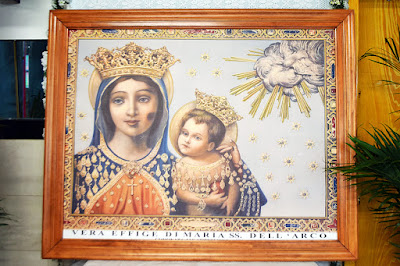 |
| Knights and Dames of the Sacred Military Constantinian Order of St. George Photos courtesy of the Sacred Military Constantinian Order of St. George |
We declare and promise to Almighty God, to Jesus Christ His only Son our Lord, with the assistance of the Holy Spirit, the maternal protection of the Blessed Virgin Mary and the powerful intercession of St. George the Martyr, to observe as true Soldiers of Christ all that we are asked and recommended. ~ Postulants for investiture in the Sacred Military Constantinian Order of St. George
 |
| The Labarum |
Following Mass, new and promoted Knights of the Royal Order of Francis I (ROFI) were invested at a ceremony presided by our esteemed Delegate, Gr. Uff. John M. Viola at the nearby Columbus Citizens Foundation.
The new and promoted Knights and Dames were admitted by command of His Royal Highness, Prince Carlo Maria Bernardo Gennaro of Bourbon of the Two Sicilies, by the Grace of God and Hereditary Right, Duke of Castro, Head of the Royal House of Bourbon—Two Sicilies, Grand Master of the Dynastic Orders of the Royal House. IHSV
 |
| The crucifer and standard bearer led the entrance procession |
 |
| Baron Thibault de Saint Vincent and Baroness Heidi de Saint Vincent |
 |
| Postulants for the Constantiniam Militia are seated near the bye-altar |
 |
| Most Rev. Gr. Cr. Arthur J. Serratelli blessed the postulants |
 |
| Congratulations Dame Marianna Gatto |
 |
| Congratulations Dame Alexis Carra-Tracey and Cav. Vito Totino |
 |
| Congratulations Dame Suzanne Pearson |
 |
| Congratulations Cav. Rev. Leo Joseph Camurati, O.P. |
 |
| Newly invested Knights and Dames are seated in choir for Mass |
 |
| Mass was celebrated by Most Rev. Gr. Cr. Arthur J. Serratelli |
 |
| Gr. Uff. John M. Viola at the nearby Columbus Citizens Foundation |
 |
| (L) Miniature medals and rosettes were awarded to the postulants. (R) Sash and breast star of the Royal Order of Francis I |
 |
| Congratulations Cav. Max Bornstein |
 |
| Congratulations Cav. Vincent Gangone |
 |
| Congratulations Cav. John Napoli |
 |
| Congratulations Cav. Theodore Jacobsen |
 |
| Cav. Jacobsen was promoted to Knight Grand Cross of the Royal Order of Francis I |
 |
| (L) Cav. Napoli and Cav. Gangone with Delegate Gr. Uff. John M. Viola. (R) Ecclesiastical Knight of Grace Rev. Leo Joseph Camurati, O.P. |
 |
| Cav. Vito Totino and Erin |
 |
| The Gangone men with Rev. Canon Matthew Talarico and Fr. Ernest Rush |
 |
| Dame Suzanne Pearson with Cav. John Napoli |
 |
| Cav. Charles Sant'Elia with Cav. Jude Tiscornia and Catherine |
 |
| (L) Miniature medals of the Sacred Military Constantinian Order of St. George & Royal Order of Francis I. (R) Tie with emblems of the Royal Order of Francis I |
 |
| Rosette and miniature medal of the Royal Order of Francis I |































